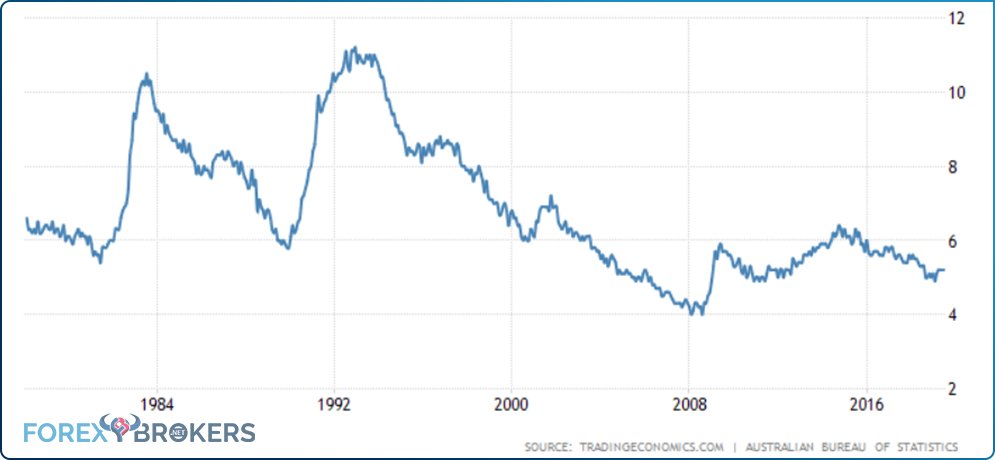A critical piece of economic data for every country, job data reveals the strength of an economy and its future potential growth. Put simply, without job creation and a low unemployment rate, an economy has a hard time growing consistently.
As it turns out, in any economy, unemployment sees its highest point just before recovery starts. When people lose hope, and everyone only sees the dark side, the economy begins to recover, and unemployment shoots down.
This happens due to the so-called business cycle, a concept that defines how economies around the world (and, indeed, the global economy) evolve and move from recession to expansion. Following the same logic, unemployment is at its lowest level at the peak of an economy.
The ability of an economy to create jobs is critical. Some central banks around the world, such as the Federal Reserve of the United States (Fed) and, recently, the Reserve Bank of New Zealand (RBNZ), have job creation as part of their monetary policy mandate.
That means that the central banks raise or lower the short-term interest rates based on how the job market performs. In some cases, like in the United States following the 2008 financial crisis, the Fed used the unemployment rate as a threshold to end one of the many quantitative easing programs it was running.
Therefore, job creation and the stability of the job market define an economy. Because the strength or weakness of a currency depends on the economic performance of the country or region, job data releases all over the world play a significant role in the currency market’s volatility.
In this article, we’ll define the labor market and emphasize the role of the unemployment rate. Then, we’ll move on, covering the job data around the world that moves the market.

Defining the Labor Market
As you’ve probably noticed, this is yet another article dedicated to fundamental analysis. It goes without saying that fundamental and technical analysis work hand in hand to provide traders with the full picture necessary for successful trading.
Before going into more detail regarding the labor force and job data, we need to clarify why low unemployment appears at the start of a downturn. After all, if unemployment is low or very low, this should benefit the economy, right?
That’s half true. While low unemployment is beneficial for an economy, it leads to a tight labor market. Historically, a tight labor market signals a business cycle downturn because workers begin asking for higher wages.
If employers can’t find enough workers to hire anymore due to tight labor market conditions, they will be forced to raise wages. Workers ask for higher wages because they expect the price of goods and services to increase in the near future. Thus, inflation expectations rise, and employers are forced to raise prices for their products way in advance.

Long story short, this is how a vicious circle starts affecting the economy and explains why some central banks, the Fed included, look at both inflation and job creation when setting the monetary policy. More about that in other articles. For now, let’s go back to the labor market and what defines it. By now, you should have a clear picture of why the job data is important both for traders and central bankers and why it creates volatility in all markets, not only the currency one.
Interpreting the Labor Data
Later in this trading academy, we’ll examine the United States job market in detail. We’ll have a look at the full Non-Farm Payrolls (NFP) report and other particularities of the United States job market because of USD’s importance in the overall Forex dashboard.
Before reaching that point, though, we need to define some terms to help us interpret the labor market in all parts of the world. These conditions form in all economies, from Japan to Australia, to Canada, to the Eurozone: There exist everywhere an unemployment rate and other labor categories. Most of these categories are not published by the time job data is released as part of the economic calendar. Therefore, for a full picture of the overall state of the job market in a particular country, savvy traders dig for details in other reports, usually issued by statistical departments and various other research groups.

Let’s start with the employed people. This data is very easy to understand, as this category comprises all people with a job. However, illegal workers do not appear in this figure, so if you’re analyzing an economy where it is common for people to work without a contract, the employed people number will be misleading.
The Participation Ratio and Unemployed People
An essential concept here is the participation ratio. Also called the activity ratio, it indicates how many people of the total working-age population are working. For instance, if the working-age range in an economy is 18 to 67, it is easy to find statistical reports that show how many people in the country are in that age range. The participation ratio shows how many of them have a job and are actively working.
Why is this important? Some people simply do not want to work. Others are in between jobs. Others yet are working illegally. This ratio tells us how close the official (government) figures are to reality. Obviously, the higher the ratio, the better for the job data and for the currency.
The number of unemployed people shows the people that don’t currently have a job but are looking for one. A more precise definition of “unemployed people” would refer not only to those seeking employment but also those who don’t want to work. Again, not everyone that’s not working is seeking employment, but the number of unemployed people represents the ones wanting to work and actively looking but not managing to get a job.
There are two categories of unemployed people. The first one is long-term unemployed people or people that haven’t been able to get a job for a few months already despite looking (typically four months). However, they’re still looking for a job.
The second category these are people that are looking for a job matching their qualifications. They won’t accept just any job but rather one that matches their skills, interests, desired location, and so on. These people are called frictionally unemployed people and, in a way, are just people between jobs, but it just so happened that they weren’t working when the unemployed data was compiled.
Issues with the Unemployment Rate
Present in all job data reports around the world, the unemployment rate accounts for people that are not working but would like to. Typically, the unemployment rate is presented in the form of a percentage of the total labor force.
Later in the article, we’ll cover the specifics of unemployment rates in various countries around the world, such as when the data is released. Until then, traders must understand that this indicator, while important, is a lagging indicator for at least a couple of reasons.
First, the labor force expands and declines, reacting to the economic conditions. A contracting economy results in a rise in the unemployment rate, while an expanding economy results in a fall. In other words, the indicator follows the economy or the business cycle and not the other way around.
Another reason why the unemployment rate lags behind the cycle is the reluctance of employers to lay off workers. So, it may be that the economy has already started to contract, but the unemployment rate still shows minimal levels due to this reluctance. Various reasons lead to this reluctance, such as contracts that are challenging to break.
Another issue with the unemployment rate is that it doesn’t account for underemployed people. It does count them as “unemployed,” but some people argue that it shouldn’t. What is an underemployed person? A person that works a job but has qualifications to work a job that pays much more.
Various reasons may lead to underemployment, such as the lack of quality jobs in a particular area. Thus, to cover the costs of living, some people may consider underemployment, at least temporarily.
Discouraged Workers and People That Don’t Want to Work
The second category includes, for instance, people who retire early. These people may appear as an active labor force in the statistics, but they may have enough money not to want to take a job. This category also includes people that simply do not want to work unless the job pays a specific amount or for any other reason.
Discouraged workers also do not appear in the official unemployment rate. While controversial because they are active, unemployed people able to work, the unemployment rate doesn’t account for people that gave up looking for work. It is no wonder that sometimes, the actual job number shows an increase, but at the same time, the unemployment rate also increases. For instance, together with the NFP, the US Bureau of Labor Statistics also releases the unemployment rate data as a percentage of the total labor force.
Many times, the NFP shows an increase, but the unemployment rate has also risen. Logically, the more employed people there are, the lower the unemployment rate should be. This phenomenon arises because of all the anomalies explained so far in this article, starting with the lagging nature of the unemployment rate and ending with not accounting for discouraged workers.
Job Data Around the World
At this point in this article, it is time to see how job data is presented around the world and its impact on the currency market. After all, fundamental analysis is meant to help traders understand the economic impact of various economic releases and use the info to profit from the currencies’ volatility.
We’ll look at the major economies from right to left on the world map, examining the way the currency market opens at the beginning of the trading week and closes at the end of it.
Japanese Job Data
Japan has a special economy from various points of view. Due to Japan’s unique culture, immigrants have a difficult time integrating into the Japanese workforce. Also, it’s not like Japan makes it a smooth process for immigrants, either, as it has some of the toughest immigration laws in the world.
Why are we talking about immigration in a job data article? The reason is that Japan is facing a demographic problem. On the one hand, the population is growing older and living longer than previous generations. On the other hand, the younger population doesn’t want to have that many kids anymore (a rising trend across most developed economies). These factors lead to a massive imbalance in the labor force. While people tend to work more, there just aren’t enough people joining the labor force due to the diminishing demographics.
In any case, the Japanese job data is formed out of only one release: the unemployment rate. Also called the Jobless Rate, it has a minimal effect on the value of the JPY, thus creating little or no market movement.
As a matter of fact, the unemployment rate in Japan is marked in yellow on the economic calendar, indicating third-tier economic data. In the previous article in this academy, we explained the difference between first-, second-, and third-tier data and their effects on the currency market.
The unemployment rate in Japan comes out around 30 days after each month ends, adding to the lagging factor mentioned earlier. Moreover, the reason why it is viewed as having little or no impact on the market (and thus treated as third-tier economic data) is that the Japanese economy relies more on the industrial sector than on personal spending.
Typically released on the 30th of each trading month, it has little or no impact on the JPY. Hence, traders ignore it most of the time unless it shows an unexpected value that differs significantly from the forecast.
Job Data in New Zealand
The unemployment rate released in New Zealand is a bit different from those in other countries. It should come as no surprise, as the Reserve Bank of New Zealand (RBNZ) is one of the most innovative central banks in the world. So why wouldn’t the unemployment rate economic release also be unique?
Jokes aside, the New Zealand economy deserves special treatment. It is said that there are more sheep than people in this tiny country, and that says a lot about the GDP and where most of the revenue comes from.
The unemployment rate is released quarterly, not monthly, as is the case in most other developed economies. Moreover, there’s a one-month lag from the end of the quarter until the actual release, making it even more difficult for those interested in feeling the pulse of the New Zealand job market to interpret it correctly. About 2.9 million people are employed in New Zealand, with an unemployment rate of around 3.9%.
The release does have an impact, though, on the NZD and its related currency pairs, as the event creates volatility. As a side note, currency traders care a lot about this release because many retail traders prefer NZD pairs due to the very low margin requirements requested by brokerage houses.
Job Data in Australia
The unemployment rate in Australia is closely watched in Asia as one of the most significant economic releases from that part of the world. Australia’s economy plays a crucial role in regional development and has enjoyed one of the longest-lasting booming periods in recent memory.
Due to the country’s close economic ties with China, the state of its job market says a lot about the ability of Australia to honor its export commitments. Also, the release creates volatility in the currency market, with the Australian dollar (AUD) reacting strongly to any outcome that misses the forecast.
Because of the somewhat isolated economy, partly because of the distance from the rest of the world, Australia doesn’t participate in global upturns and downturns like other economies. This is both a blessing and a curse.
It is a curse because the Australian economy has a hard time integrating and correlating with the other developed economies in the world. But, at the same time, it’s a blessing because sometimes isolation helps. For instance, the 2008 financial crisis that started in the United States quickly spread around the world, gripping most major economies. The Australian economy did suffer, but not as much as other economies. For this reason, we can say that this is a relatively stable economy with a relatively stable unemployment rate.
Given the economy’s stability, it comes as no surprise that for the last 15 years, the unemployment rate in Australia has fluctuated between 4% and 6%, offering an example of how a balanced job market looks. From 1978 to 2019, the Australian unemployment rate averaged 6.83%, which is not bad by all standards. Released in the middle of each month and covering the previous month, this release is closely watched by any trader with interest in the AUD pairs.

Eurozone Unemployment Rate
The Eurozone is a unique case in modern economics. It comprises a number of distinct countries, each one with a different economy and characteristics.
For instance, you can’t compare the Dutch economy with the Greek economy, nor the Spanish one with the Austrian one. Therefore, setting the monetary policy for the Eurozone is a daunting task, with the European Central Bank (ECB) struggling to do an excellent job since the euro’s inception.
The euro recently celebrated 20 years of existence, making it a success for much of the Eurozone and the European project. Out of all the economic data coming out of the Eurozone, the unemployment rate is one of the most relevant ones.
Obviously, because the economies making up the Eurozone are so distinct, traders must take the data with a grain of salt. For instance, the unemployment rate in the Eurozone just dropped to 7.5% in July 2019, a record 11-year low.
A close look at the details, however, reveals huge differences between the unemployment rate in Germany, for instance, and Spain. Therefore, interpreting the unemployment rate in the Eurozone isn’t as straightforward as many would think. We are talking about an average, in a way resembling how the United States calculates its unemployment rate for the entire country: in some states, it is higher, and in some states, it is lower.
The data is released monthly, toward the end of the trading month or the beginning of the new one, and refers to the previous month. Despite its importance, it is rarely a market-moving event, as the actual doesn’t usually differ much from the forecast.
On top of that, the ECB doesn’t have a mandate that considers job creation, like the Fed in the States does. Therefore, many times, the eurozone unemployment rate goes unnoticed by traders, as it creates little or no volatility.
Job Data in the United Kingdom
Due out around the middle of each month, the job data in the United Kingdom reveals both the number of new jobs created and the unemployment rate. An interesting fact: The data is marked as third-tier data, marked in yellow on the economic calendar.
Three releases define the job data in the United Kingdom:
- Unemployment Rate
This is the standard unemployment rate, released about 45 days after the month ends.
- Claimant Count Change
This is a tricky release because it shows the number of unemployed claims. The lower the number, the better for the currency, not the other way around.
- Average Earnings Index 3m/y
This shows the change in the price paid for labor by businesses and the government.
Putting together the info provided by these three releases offers traders a glimpse into one of the most lucrative job markets in the world. Lately, it has deserved special attention due to the uncertainties surrounding the Brexit referendum in 2016, as three years later, there’s no indication of how Brexit will end.
As such, businesses are reluctant to hire people or invest, making it difficult to assess the true state of the United Kingdom’s job market.
Canada and Its Job Market
One of the most challenging job data areas to interpret and trade, the Canadian job market is full of surprises, not just due to the interpretation per se but also because it creates confusion when trading USDCAD, the only major pair with CAD in its componence.
The problem comes from the release time. The employment change and the unemployment rate (the two releases that make up the job data in Canada) come out at the same time as the NFP in the United States.
As such, trading the USDCAD is pure madness. For example, the Canadian data may be disappointing, but the NFP is disappointing too, also missing the forecast. The first release would be bullish for USDCAD, but the second would be bearish. How do you trade the pair in such a case? Don’t say that it depends on how much it misses the target because that’s not relevant due to the different sizes of the two economies.
In any case, CAD pairs react strongly to Canadian job releases. What’s more important is that the job data in Canada often offers staggering surprises.
United States Job Market
For currency traders, no other job market is as important as the one in the United States of America. Traders look at economic releases and gather clues as to what the central bank will do next.
While the above statement is true for all economies, central banks, and currencies, job creation in the United States has a special place in the interpretation of economic data. Everyone looks at the job report in America.
No matter what corner of the world you live in, what happens in the United States job market matters to everyone. To traders, it matters because the release influences the value of USD.
To everyone else, the release reveals how the strongest economy in the world is performing. Strong performance implies the global economy is in good shape, and the implications are that the local job market, wherever you are, is strong, too. Conversely, weak job data in the United States signals a drop in global economic growth and a potential weakness in local and regional markets.
The Fed considers job creation when setting the monetary policy. For this reason, consistent job growth coupled with inflation moving toward the Fed’s target signals potential hawkish statements and, eventually, a rate hike.
Alternatively, a declining job market accompanied by inflation consistently missing the target leads to a rate cut, which is dovish for the USD.
ADP and NFP
Every first week of the month, the ADP (private payrolls) and NFP (Non-Farm Payrolls) shape the trading conditions. The consensus is that ADP comes out on Wednesday during the NFP week, and the NFP comes out on Friday.
However, sometimes when there’s a holiday on any of the weekdays before the NFP, the ADP may be released one day earlier or later. If that’s the case, it typically comes out one day later.
For some traders, the ADP is even more important than the NFP. We won’t go into the details regarding how to trade the two releases in this article, but it is useful to know that this trading academy has a full article dedicated to the NFP’s importance and how to make the most of any given NFP week.
Unemployment Rate in the United States
Leaving the NFP aside, the unemployment rate comes out at the same time as the NFP. As already stated in this article, sometimes the NFP beats expectations, but the unemployment rate still rises, or the other way around. Therefore, trading solely on the unemployment rate data or only on the NFP data is not advisable.
Average Hourly Earnings MoM and YoY
Either monthly or yearly, the average hourly earnings (AHE) measures the price businesses pay for their workforce. As an economic release part of the overall job data, it has implications for the other “half” of the Fed’s mandate: namely, inflation.
A constant increase in the AHE leaves more money in consumers’ pockets. Therefore, personal income rises, and with it, personal spending.
The law of demand tells us that for most products, the demand curve has a negative slope. Effectively, that means that consumers are inclined to buy more if the price of goods and services declines and less if the price increases.
But the price is only one driving force for the demand curve. Income is another. The so-called income effect refers to consumers buying more due to the wages they receive having larger purchasing power. However, if the AHE is on the rise, the income effect is reinforced by consumers having more money to spend. Obviously, this is only the case if inflation stays still.
As you can see, balancing inflation and the labor market to set up interest rates is not easy. The Fed, therefore, has the toughest job compared to the other central banks.
Participation Rate
We already mentioned the labor force participation rate in this article and its role in the interpretation of the job data of an economy. However, at this point, we’d like to show you what normal levels for the Labor Force Participation Rate are.
In the United States, the labor force participation rate averaged 62.99% for the last 69 years, with an all-time high of 67.30% in January 2000 and a record low of 58.1% in December 1954.
The idea of showing this data here is to pinpoint something many retail traders miss. As not everyone has an economic background, some traders interpret a print of 64% as bearish for USD, as it shows a poor participation rate. However, by historical standards, it is above average and actually bullish for the USD. If accompanied by positive data on other indicators like the unemployment rate or the AHE, it indicates a robust job market as a result of a healthy economy.
Productivity and Its Connection with Payroll Employment
As is always the case when interpreting macro data, the real answer lies somewhere in the middle. For some, the data may seem bullish, and for others, bearish. Any trader looking for a reaction further ahead in time than the first few hours after the job data comes out must look at the details.
For instance, the unemployment rate in Spain declined from a staggering 27% in 2013 to about 14% in 2019: A true success story.
However, a closer look at the details reveals that most of the jobs created are temporary, not permanent contracts. Yes, there’s a trend in the world for people to work remotely, to freelance, but traders and analysts must compare apples to apples. Therefore, when comparing the job data of various countries, it is wise to compare permanent contracts to permanent contracts, temporary contracts to temporary contracts, and so on.
Speaking of temporary contracts, interpreting the use of temporary workers is one way to measure and understand the employment situation in any given country. It helps determine the business cycle and where the economy might head next.
For instance, the typical way for a business to react to a cyclical upswing is to increase overtime hours. Managers simply ask workers to work overtime and pay for those hours accordingly.
Next, the business begins hiring temporary workers. This is indeed a sign of increasing economic recovery, an encouraging aspect for the economy. In this case, the example from Spain proved right: Eventually, many of the temporary contracts turned into permanent ones, triggering a steep decline in the unemployment rate.
Conclusion
As this article has shown, despite showing the same thing, each job data release has its own particularities. It reflects the shape and characteristics of each economy.
In some cases, like Japan, it has little or no significance for the currency market. But for most economies, the job data is crucial for understanding how they are performing.
If the job data is tightly tied to monetary policy decisions (like in the United States), it is crucial for the direction of the country’s currency. If you add to this the fact that USD is the world’s reserve currency, it is easy to see why the NFP in the States is responsible for aggressive market moves.
It’s not easy to interpret the job data and trade on what the job market shows. In fact, macro trading, or fundamental trading, is as tricky as technical trading. With so many factors to consider and interpret, traders quickly get lost in the details and miss the real interpretation.
When markets move fast, as they often do, traders must react immediately, with little or no time to think much. Add to this the invariable emotional rollercoaster, and you have a cocktail destined to create problems in almost any retail portfolio.
So far in this Trading Academy, we’ve treated job data with the respect it deserves. Only inflation plays as important a role for the currency trader as job data. For this reason, future fundamental articles will deal with inflation and its connection with job data when interpreting what the central banks will do next with the interest rates.

























